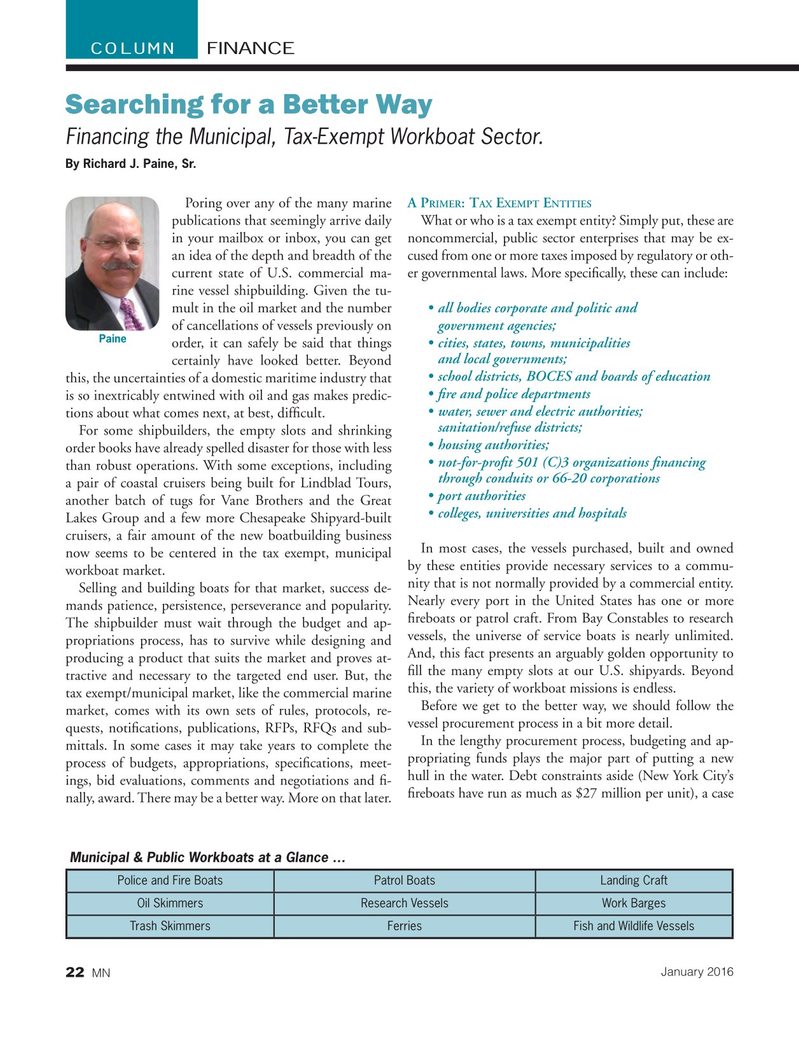
Page 22: of Marine News Magazine (January 2016)
Read this page in Pdf, Flash or Html5 edition of January 2016 Marine News Magazine
COLUMN FINANCE
Searching for a Better Way
Financing the Municipal, Tax-Exempt Workboat Sector.
By Richard J. Paine, Sr.
Poring over any of the many marine A P : T E ERIMER AX XEMPT NTITIES publications that seemingly arrive daily What or who is a tax exempt entity? Simply put, these are in your mailbox or inbox, you can get noncommercial, public sector enterprises that may be ex- an idea of the depth and breadth of the cused from one or more taxes imposed by regulatory or oth- current state of U.S. commercial ma- er governmental laws. More speci? cally, these can include: rine vessel shipbuilding. Given the tu- mult in the oil market and the number • all bodies corporate and politic and of cancellations of vessels previously on government agencies;
Paine order, it can safely be said that things • cities, states, towns, municipalities certainly have looked better. Beyond and local governments; • school districts, BOCES and boards of education this, the uncertainties of a domestic maritime industry that • ? re and police departments is so inextricably entwined with oil and gas makes predic- • water, sewer and electric authorities; tions about what comes next, at best, dif? cult. sanitation/refuse districts;
For some shipbuilders, the empty slots and shrinking • housing authorities; order books have already spelled disaster for those with less • not-for-pro? t 501 (C)3 organizations ? nancing than robust operations. With some exceptions, including through conduits or 66-20 corporations a pair of coastal cruisers being built for Lindblad Tours, • port authorities another batch of tugs for Vane Brothers and the Great • colleges, universities and hospitals
Lakes Group and a few more Chesapeake Shipyard-built cruisers, a fair amount of the new boatbuilding business
In most cases, the vessels purchased, built and owned now seems to be centered in the tax exempt, municipal by these entities provide necessary services to a commu- workboat market. nity that is not normally provided by a commercial entity.
Selling and building boats for that market, success de- mands patience, persistence, perseverance and popularity. Nearly every port in the United States has one or more ? reboats or patrol craft. From Bay Constables to research
The shipbuilder must wait through the budget and ap- propriations process, has to survive while designing and vessels, the universe of service boats is nearly unlimited.
And, this fact presents an arguably golden opportunity to producing a product that suits the market and proves at- tractive and necessary to the targeted end user. But, the ? ll the many empty slots at our U.S. shipyards. Beyond tax exempt/municipal market, like the commercial marine this, the variety of workboat missions is endless.
Before we get to the better way, we should follow the market, comes with its own sets of rules, protocols, re- vessel procurement process in a bit more detail.
quests, noti? cations, publications, RFPs, RFQs and sub-
In the lengthy procurement process, budgeting and ap- mittals. In some cases it may take years to complete the propriating funds plays the major part of putting a new process of budgets, appropriations, speci? cations, meet- hull in the water. Debt constraints aside (New York City’s ings, bid evaluations, comments and negotiations and ? - ? reboats have run as much as $27 million per unit), a case nally, award. There may be a better way. More on that later.
Municipal & Public Workboats at a Glance …
Police and Fire Boats Patrol Boats Landing Craft
Oil Skimmers Research Vessels Work Barges
Trash Skimmers Ferries Fish and Wildlife Vessels
January 2016 22
MN
MN Jan16 Layout 18-31.indd 22 1/6/2016 2:46:58 PM

 21
21

 23
23
